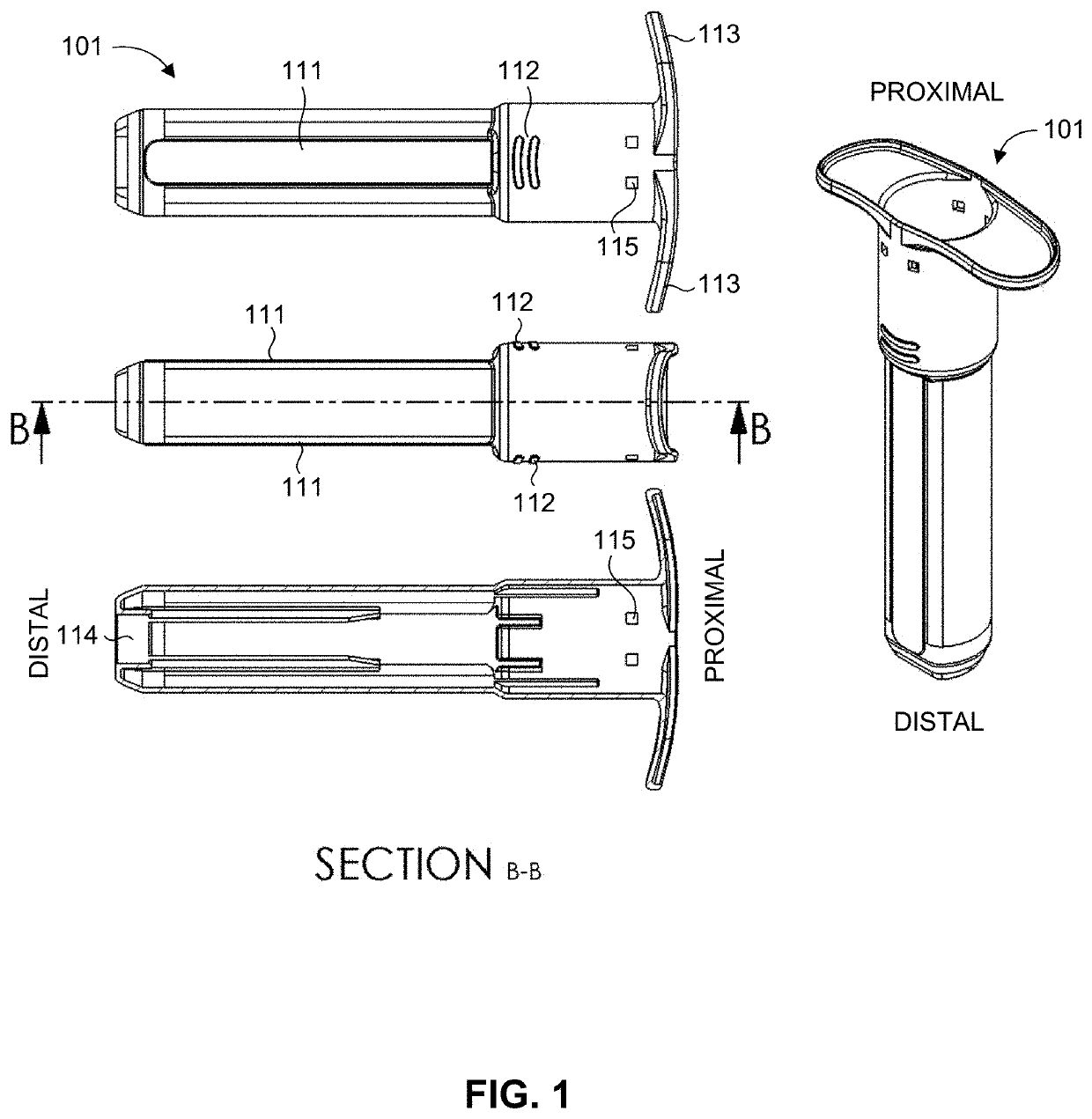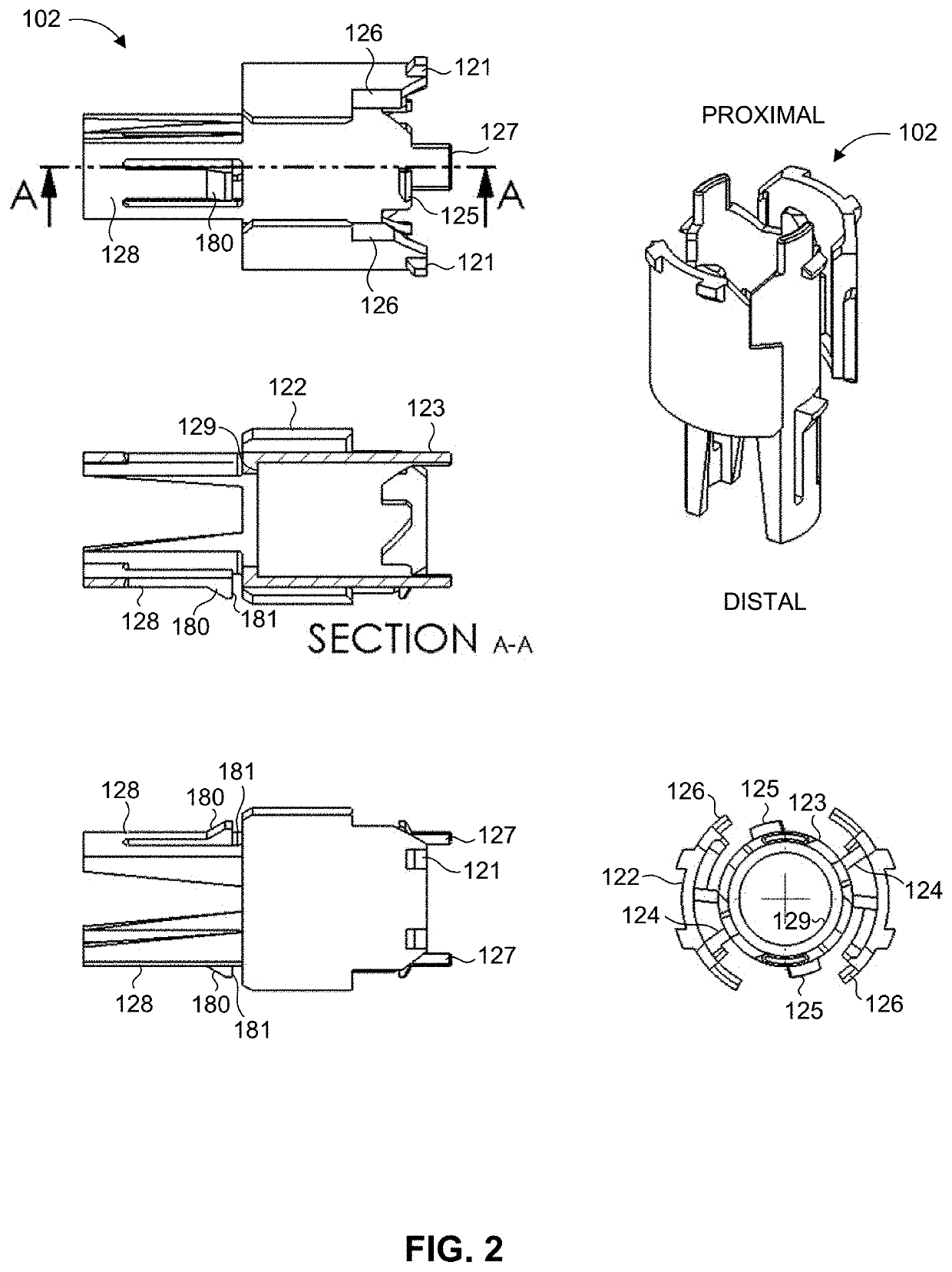Automatically retracting safety needle assembly
a safety needle and automatic retracting technology, which is applied in the field of safety needle assemblies, can solve the problems of contamination and needlestick injury of still extended and used needles, difficulty in fully pushing the plunger all the way, and inability to fully depress the plunger. to prevent proximal movement
- Summary
- Abstract
- Description
- Claims
- Application Information
AI Technical Summary
Benefits of technology
Problems solved by technology
Method used
Image
Examples
first embodiment
[0052]Reference is now made to FIGS. 1 through 14, which collectively illustrate a safety needle assembly, generally referenced 100, according to the present invention. Assembly 100 includes an external housing (EH) 101, an internal housing (IH) 102, a rotating sleeve (ROS) 103, a biasing element (BE) 104, an activation fork (AF) 105, and a syringe 106. Assembly 100 has a distal end and a proximal end, which is depicted in FIG. 1 in the context of external housing 101, where the distal end faces away from the user holding assembly 100 and towards the injection site. Assembly 100 is also defined by a longitudinal axis, extending lengthwise along the assembly between the proximal and distal ends, where an “axial” direction corresponds to a direction parallel to the longitudinal axis (i.e., towards or away from the proximal or distal ends), whereas a “radial” direction corresponds to a direction orthogonal to the longitudinal axis, and extending radially therefrom.
[0053]FIG. 1 is an il...
second embodiment
[0071]Reference is now made to FIGS. 15 through 27, which collectively illustrate a safety needle assembly, generally referenced 200, according to the present invention. Assembly 200 includes an external housing (EH) 201, an internal housing (IH) 202, a locking sleeve (LOS) 203, a biasing element (BE) 204, an activation fork (AF) 205, and a syringe 206. Assembly 200 has a distal end and a proximal end, which is depicted in FIG. 15 in the context of external housing 201, where the distal end faces away from the user holding assembly 200 and towards the injection site. Assembly 200 is also defined by a longitudinal axis, extending lengthwise along the assembly between the proximal and distal ends, where an “axial” direction corresponds to a direction parallel to the longitudinal axis (i.e., towards or away from the proximal or distal ends), whereas a “radial” direction corresponds to a direction orthogonal to the longitudinal axis, and extending radially therefrom.
[0072]External housi...
third embodiment
[0089]Reference is now made to FIGS. 31 through 47, which collectively illustrate a safety needle assembly, generally referenced 400, according to the present invention. Assembly 400 includes an external housing (EH) 401, an internal housing (IH) 402, a locking sleeve (LOS) 403, a biasing element (BE) 404, an activation fork (AF) 405, a syringe 406, and an outer cap 407. Assembly 400 has a distal end and a proximal end, which is depicted in FIG. 31 in the context of external housing 401, where the distal end faces away from the user holding assembly 400 and towards the injection site. Assembly 400 is also defined by a longitudinal axis, extending lengthwise along the assembly between the proximal and distal ends, where an “axial” direction corresponds to a direction parallel to the longitudinal axis (i.e., towards or away from the proximal or distal ends), whereas a “radial” direction corresponds to a direction orthogonal to the longitudinal axis, and extending radially therefrom.
[0...
PUM
 Login to View More
Login to View More Abstract
Description
Claims
Application Information
 Login to View More
Login to View More - R&D
- Intellectual Property
- Life Sciences
- Materials
- Tech Scout
- Unparalleled Data Quality
- Higher Quality Content
- 60% Fewer Hallucinations
Browse by: Latest US Patents, China's latest patents, Technical Efficacy Thesaurus, Application Domain, Technology Topic, Popular Technical Reports.
© 2025 PatSnap. All rights reserved.Legal|Privacy policy|Modern Slavery Act Transparency Statement|Sitemap|About US| Contact US: help@patsnap.com



